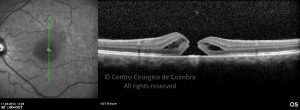Traumatic macular hole is an anatomical opening or dehiscence of the fovea, resulting from a blunt trauma that causes changes in the vitreoretinal interface, leading to loss of central vision.
This type of injury occurs in 6% of patients who have sustained blunt ocular trauma, and its pathogenesis is not fully understood. However, it is known that the formation of epiretinal membranes, atrophy of the photoreceptors of the fovea and hydraulic forces have an important role. It may be a sequel of Berlin’s edema.
Symptoms depend on the stage of the disease and include progressive loss of central vision and metamorphopsia. A large macular hole can produce a scotoma in central vision.













